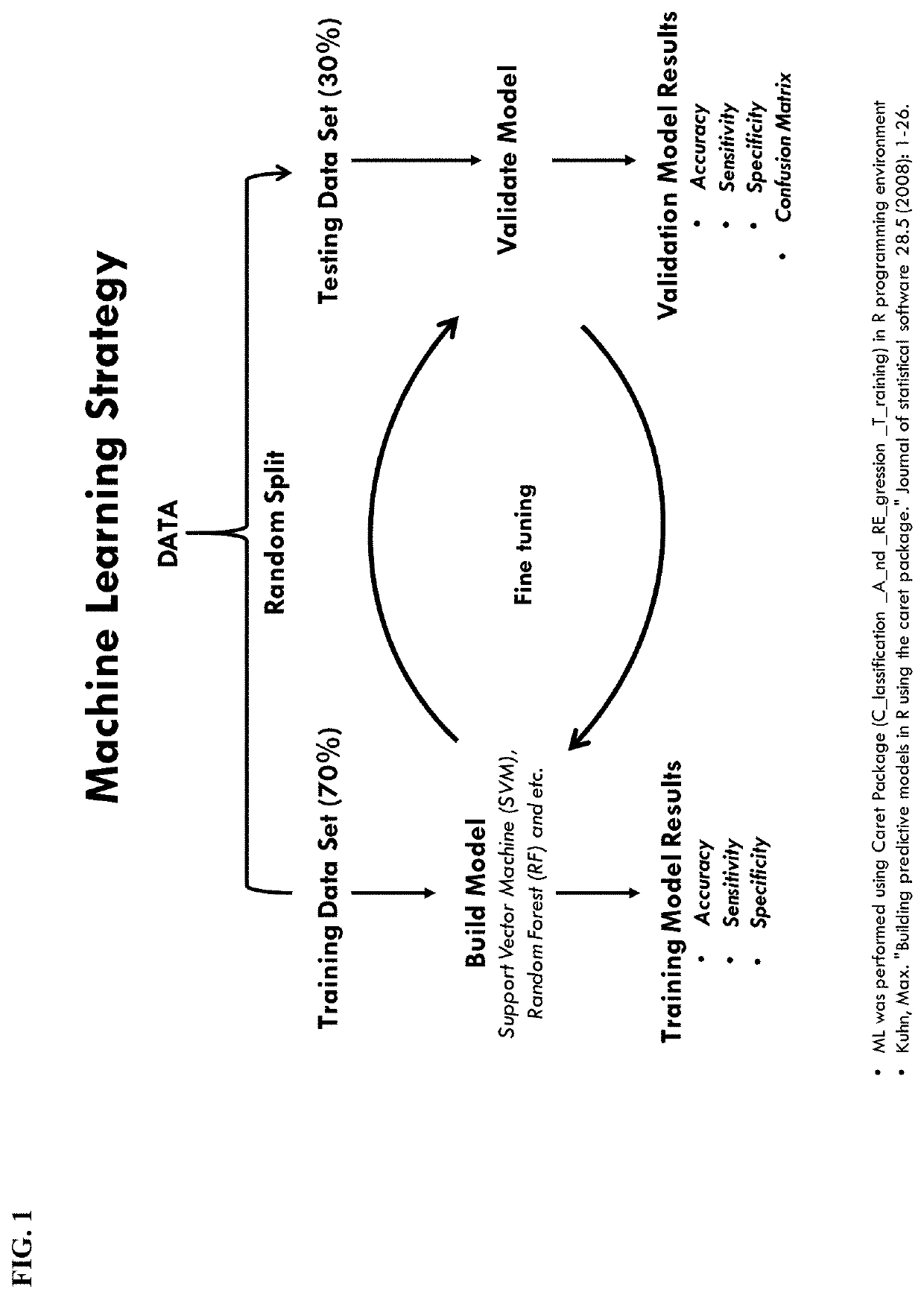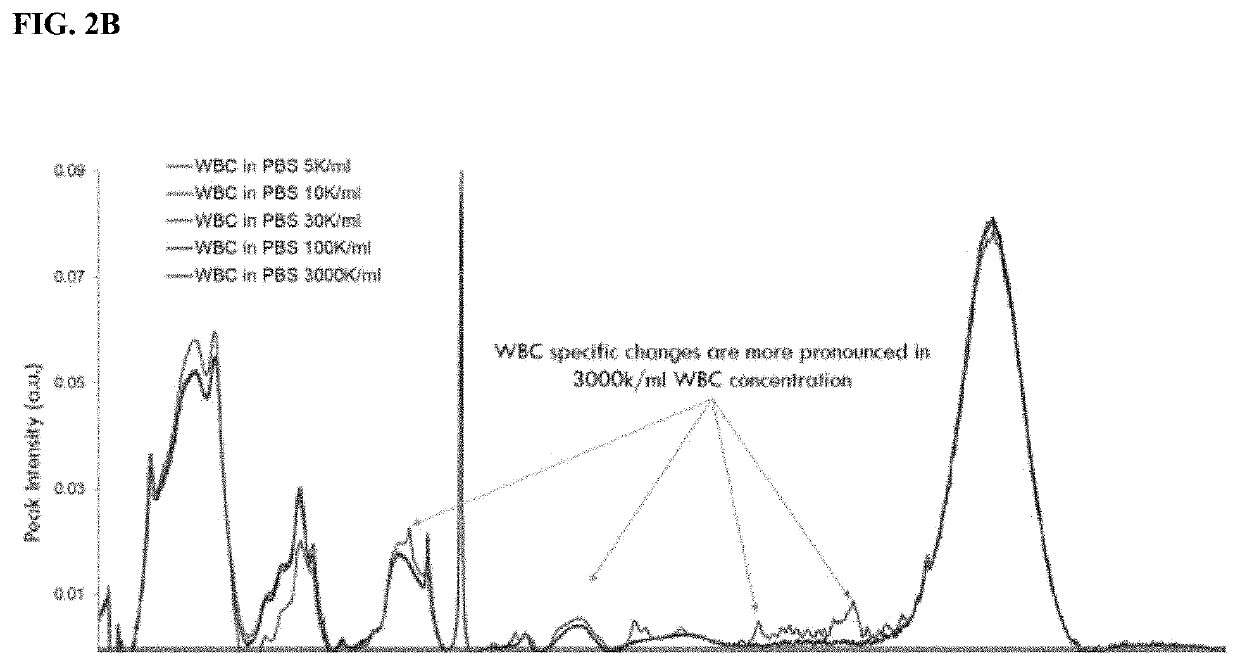Compositions and methods for diagnosing urinary tract infections
a technology for urinary tract infections and compositions, applied in the field of compositions and methods for diagnosing urinary tract infections, can solve the problems of increased frequency of urination, urgency, bloody urination and inappropriate urination in pets, and achieve the detection of utis in canine samples at the point of care, and without the need for costly and time-consuming reagents. , the effect of simple sample preparation
- Summary
- Abstract
- Description
- Claims
- Application Information
AI Technical Summary
Benefits of technology
Problems solved by technology
Method used
Image
Examples
example 1
[0056]This example describes the use of a Machine learning (FIG. 1) and a neural network to analysis Raman spectra. Data was split based on the group 70% training and 30% testing data sets. Random Forest and Support Vector Machine were used for spectral analysis. Models were optimized on training data set and their results were validated by testing data sets. Select Raman spectral regions were eliminated from analysis due to scattering, LED peaks and urea peaks.
[0057]Random Forest training is used to construct a neural network decision tree in an iterative fashion with key focal nodes which center around specific areas of interest on the Raman spectra. Branches are created and iterated based upon the amount of information gained (entropy) by the resulting node (FIG. 2A). Random Forest allows one to have an in-depth analysis with relatively small amounts of data.
[0058]Random Forest iterations are used to identify important biological differentiation factors between spectra in a libra...
example 2
[0060]This example describes the classification of bacteria genus / species using Raman spectroscopy of natural clinical canine urine samples (Uninfected vs Naturally Infected (UN)). Bacteria levels varied between 0.3 to 1 optical density (OD) in water and in contrived canine urine samples spiked with bacteria. Natural clinical samples from infected dogs were validated for the type of bacteria / colony forming units (CFU) per mL by an independent lab analysis.
[0061]Data was obtained in 100% urine, 80% water-20% urine, and 90% water-10% urine. Data is compared with that in pure water (no contact with urine) or uninfected urine.
[0062]Table 1 shows classification of gram positive and negative samples in pure water vs spiked water, uninfected urine vs spiked urine, and uninfected vs naturally infected urine. Gram classification accuracy of >95% was observed in uninfected vs spiked urine and >97% in water vs spiked water and uninfected vs naturally infected urine. FIGS. 4 and 5 show classifi...
example 3
[0063]This example describes the use of filtration methods of urine sample prior to analysis with Raman Spectroscopy. Bacteria filtration was evaluated as a less labor-intensive alternative to centrifugation. A syringe filter back flush methodology was used to compare:[0064]Mix cellulose ester syringe filters (0.2, 0.4 & 0.8 micron)[0065]Polycarbonate syringe filters (0.2, 0.4 & 0.8 micron)[0066]Nylon syringe filters (0.2, 0.4 & 0.8 micron)[0067]Polyvinylidene Fluoride (PVDF) syringe filters (0.2, 0.4 & 0.8 micron)
The OD results of urine, urine spiked with bacteria and recovered bacteria / materials after filtration were plotted.
[0068]FIG. 3 shows the different filtration methods used. Filtration of urine using any of the filtering options tested resulted in a reduction of background fluorescence in Raman spectra as compared to unfiltered urine samples. Different types of filters demonstrated different levels of bacteria recovery. FIG. 6 show the results.
PUM
| Property | Measurement | Unit |
|---|---|---|
| OD | aaaaa | aaaaa |
| Raman spectrum | aaaaa | aaaaa |
| Raman spectrometer | aaaaa | aaaaa |
Abstract
Description
Claims
Application Information
 Login to View More
Login to View More - R&D
- Intellectual Property
- Life Sciences
- Materials
- Tech Scout
- Unparalleled Data Quality
- Higher Quality Content
- 60% Fewer Hallucinations
Browse by: Latest US Patents, China's latest patents, Technical Efficacy Thesaurus, Application Domain, Technology Topic, Popular Technical Reports.
© 2025 PatSnap. All rights reserved.Legal|Privacy policy|Modern Slavery Act Transparency Statement|Sitemap|About US| Contact US: help@patsnap.com



